Grecotel Filoxenia Kalamata: The Rebirth of a Hospitality...
A historic hotel redefines modern Greek...
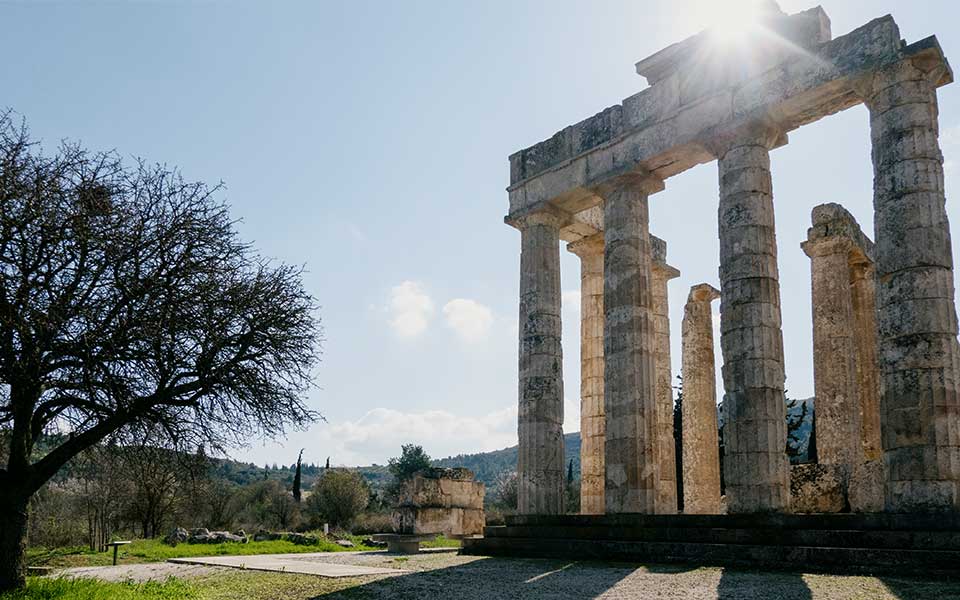
The Temple of Zeus in Nemea
© Angelos Giotopoulos
The vine growers had just finished pruning, and some little shoots had already started to sprout tender “eyes.” Rich in grapes – from the commercial vineyards of Asprokambos and Koutsi to the vine-laden courtyards of private homes – Nemea is not only the homeland of Agiorgitiko and the largest wine-producing region in Greece, it’s also a land steeped in myth and history. It was here that Heracles completed the first of his twelve labors, and here that stands the imposing Temple of Zeus in Nemea, alongside one of the best-preserved ancient stadiums in the country. There’s also the Holy Monastery of Panagia tou Vrahou, dating back to the 17th century, whose stunning views are worth the climb up the Hill of Polyfeggos.
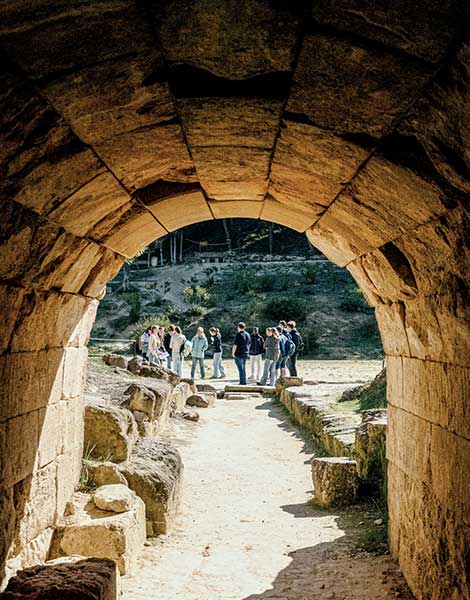
We recommend starting the visit to the archaeological site at the museum and ending at the 6th-century stadium.
© Angelos Giotopoulos
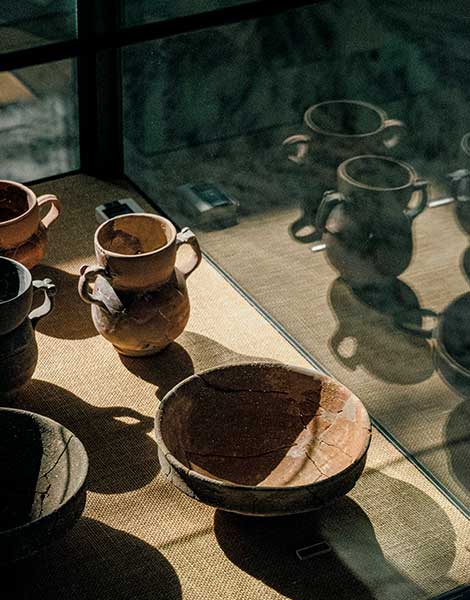
© Angelos Giotopoulos
Just 24 kilometers south of Nemea lies one of the most significant archaeological sites in Greece, Mycenae, as well as a complex of beehive tombs in Aidonia. In the mountains nearby, there’s Lake Stymphalia, part of the Natura 2000 network of protected areas; in the lowlands, the winding Asopos River flows serenely through valleys, interrupted here and there by waterfalls. In short, Nemea is richly gifted, both in natural wonders and in historical locations.
Although the main town – once called Aghios Georgios – lacks a unified architectural identity, it has a vibrant community working to make Nemea a true destination. Two brand-new hotels are already open, with two more under construction, set to open by the end of 2025. We stayed for one night at the very comfortable and welcoming Kera Neme, which has its own wine cellar and wine library, and split our time between five wineries and the archaeological site of Ancient Nemea.
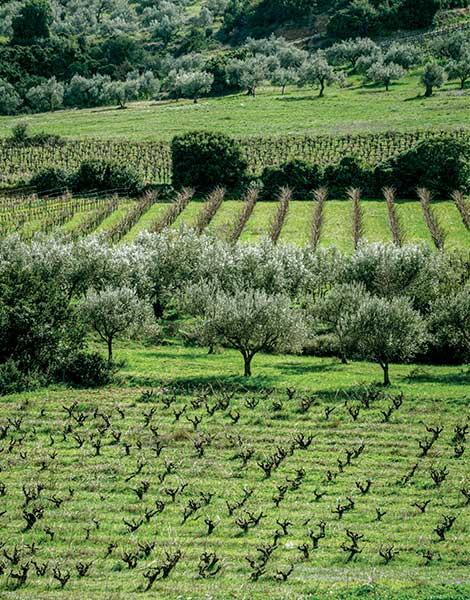
Vineyards and olive trees dominate the landscape around Nemea.
© Angelos Giotopoulos
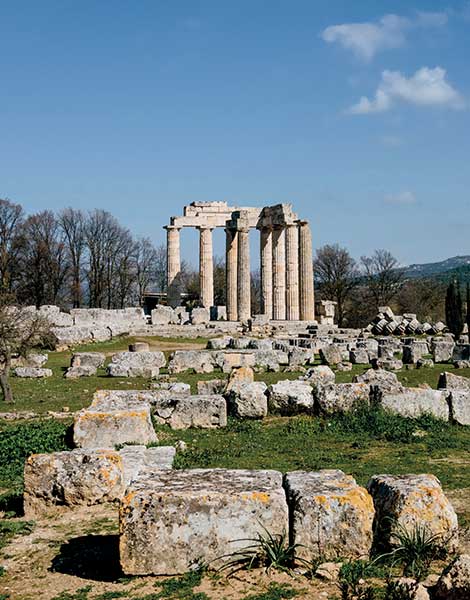
The Temple of Zeus in Nemea.
© Angelos Giotopoulos
We suggest beginning your tour of the archaeological site at the museum, which was designed following principles of modern museology. A huge picture window overlooks the site itself, and a large-scale model here will help you navigate the ancient stadium later on. Through the museum’s collection, you’ll learn that the Nemean Games, held in honor of Opheltes in antiquity, were not just local events. Historical evidence, such as coins, reveals that athletes and citizens from modern-day Turkey, Cyprus, and Italy traveled to the ancient city of Cleonae, proving the games’ wide appeal. Don’t miss the showcase with strigils, tools that athletes used to remove oil and dust from their bodies. Other items include pieces of the starting line, a stone strip remarkably well preserved. You’ll also find artifacts from the Bronze Age, including jewelry from the Treasure of Aidonia: gold items such as rings, true masterpieces of craftsmanship. The chariot race scenes depicted on them attest to the artistic skill of their creators.
The current state of the archaeological site and museum owes much to the decades-long efforts of Professor Stephen Miller and his team from the University of California, Berkeley. Miller dedicated himself with passion and persistence to the site’s restoration, working to reveal the stadium and uncovering several other important finds. Exiting the museum, you’ll see the foundations of houses that once hosted priests and sculptors, as well as the Xenon, or athletes’ accommodation, which was later transformed into a Christian basilica. On the left are the baths, which would have included changing rooms and rows of bathing basins.
Rising out of the wild grasses and flowers, the eight columns of the Temple of Zeus in Nemea stand tall, still seemingly carrying the weight of divine presence. Lower down, you’ll see the remnants of the cella, the temple’s inner chamber where sacrifices were offered. At the nearby 6th-century stadium, the stone seating and athletes’ entrance remain nearly intact. Unfortunately, the setting lacks adequate interpretive support. Sparse signage and the absence of a narrator or guide meant that we could not fully appreciate what we were seeing. To get a more complete picture, we recommend contacting Elias Papadopoulos, a guide based in Nafplio, who offers organized tours in the area.
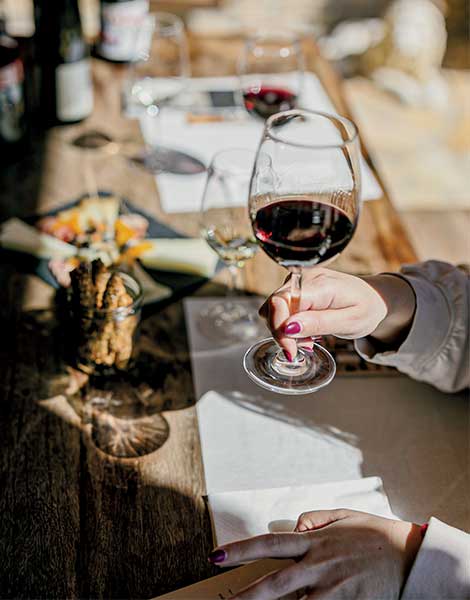
Wine tasting at the Barafakas winery.
© Angelos Giotopoulos
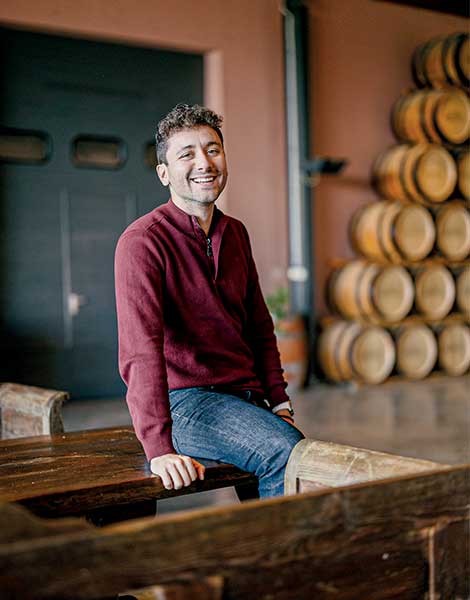
Dimitris Skouras, a worthy second-generation winemaker.
© Angelos Giotopoulos
More than forty local winemakers craft their own expressions of Agiorgitiko, the ancient Phliasian wine once offered at the Nemean Games. Nemea’s PDO (Protected Designation of Origin) red wine, made from 100% Agiorgitiko, was established in 1971. Today, the grape covers about 2,500 hectares, producing young wines, aged reds, fine rosés, elegant blanc de noirs, and aromatic dessert wines.
Some of Greece’s best-known labels come from these vineyards: Megas Oenos by Skouras, Vyssinokipos by Palivos, Gaia Estate, Palaia Klimata by Papaioannou, Oinos Orenos Ilios by Semeli, Daimon by Ieropoulos, Kokkino se Mavro by Mitravelas, Tris Magisses by Barafakas, Mythic River by Gofas, and many more. Recently, the Nemea Winemakers’ Association launched the NEMEA LIONS initiative, an international-style certification like those in Tuscany and Rioja. Wines labeled LIONS must be produced exclusively in the PDO zone, with stricter quality standards and a focus on excellent raw material. The certification also ensures environmental protection, soil fertility preservation and local producer support. Bottles with the label aim to guarantee high-quality dry red wines.
As for wine tourism? Locals have been welcoming visitors for over 20 years during the “Great Days of Nemea.” Each winery offers a unique experience, from guided tours and tastings in special rooms to friendly courtyard tables where winemakers share a glass with guests.
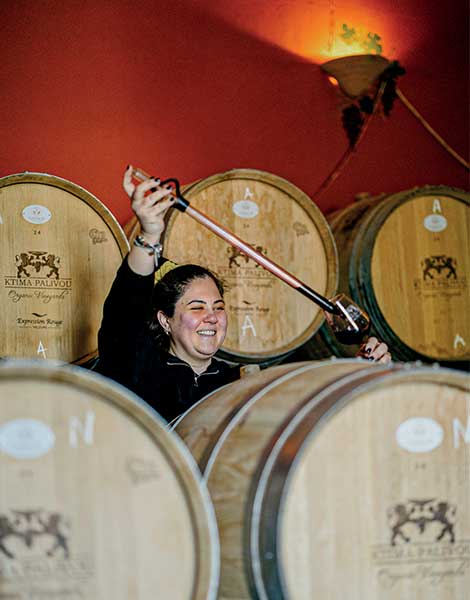
Evangelia Palivou in the cellar of the family winery.
© Angelos Giotopoulos
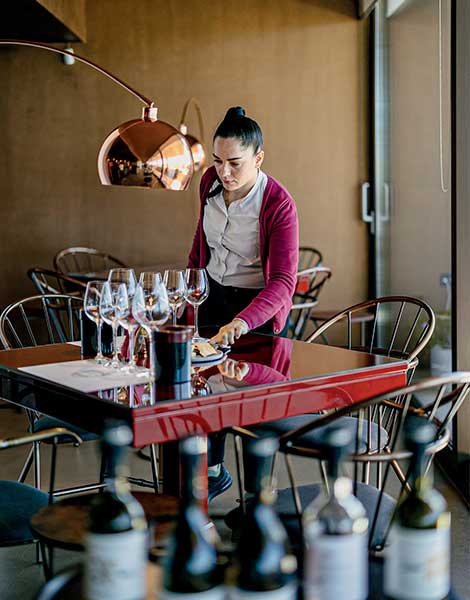
Tasting Agiorgitiko with delicious accompaniments in the well-kept space of Semeli Estate.
© Angelos Giotopoulos
A complete wine tourism experience awaits at the Semeli winery, built at an elevation of 600 meters in the village of Koutsi, with views of both the mountains and the plain. The tour leads through production areas of the gravity-flow winery, designed over four levels, and ends in a stylish art-filled space. You can choose from four tasting options, two held in the stunning cellar. The estate also has a bistro, where the chef uses mainly organic products to create modern dishes.
In the village of Archaia Nemea, the visitor experience (which was started by George Palivos and his wife Angeliki and is now being continued by their daughters Evangelia and Vasiliki) is a warm and personal wine story. At the crest of a hill, an old train car serves as a special tasting room for their premium wines – book in advance for a tasting in this stunning setting overlooking the vineyards.

The restaurant 17 Choria has an extensive wine list.
© Angelos Giotopoulos
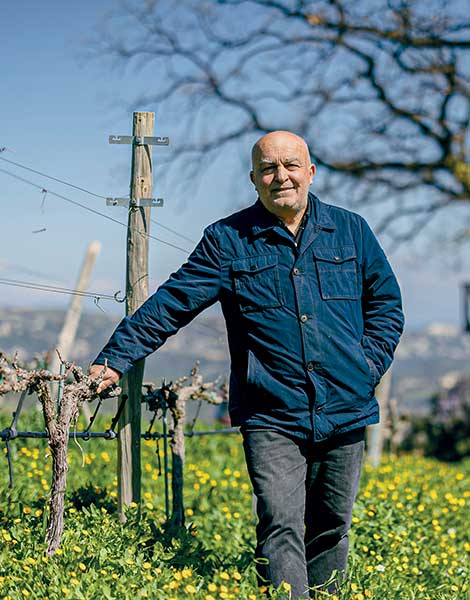
The winemaker Chronis Ieropoulos in his blooming mountain vineyard.
© Angelos Giotopoulos
Just fifteen minutes from Nemea is Domaine Skouras, founded in 1986 when George Skouras bottled his first 6,000 bottles, one by one, in his father’s garage. This bold start laid the foundation for one of Greece’s most renowned wineries. Its iconic label is Megas Oenos, a blend of Agiorgitiko and Cabernet Sauvignon that remains the flagship of the estate. The tour includes a visit to a truly impressive cellar, with over 1,000 barrels. Wine lovers can customize their tasting by selecting their favorite labels.
Some wineries aren’t open to the public at all, while others are by appointment only. For a curated tasting of unique or newer wines from wineries that do not host visits, book a spot at Venikos in central Nemea. Founded by Nikos Bouzinelos, Kostis Albanis and Dominik Brun, the company offers wine tourism and gastronomy experiences. A package might include a visit to the archaeological site, a winery tour, and a meal in Koutsi at “Wisdom of Nature” (an artisanal producer of grape must and vinegar products, this enterprise is run by Bouzinelos and Kostas Banagis). In the Venikos tasting room and shop, we took a masterclass in Agiorgitiko, sampling four expressions that ranged from sparkling to red.
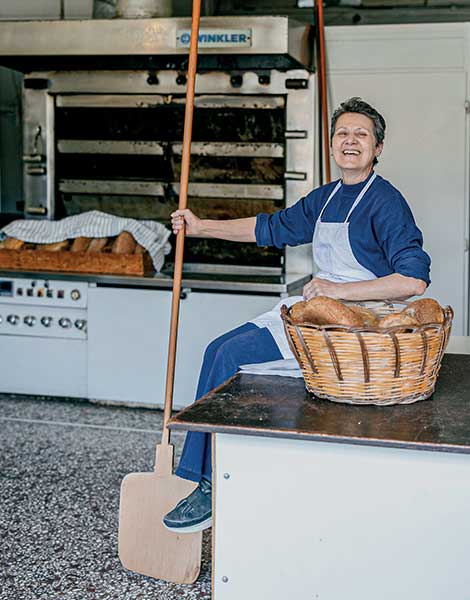
Nota, a renowned baker at Stavropoulos Bakery.
© Angelos Giotopoulo
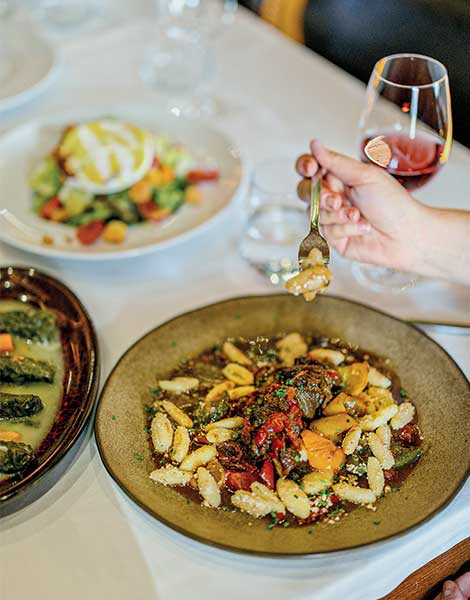
Delicious local cuisine at Sofos’ restaurant.
© Angelos Giotopoulo
No visit to the area is complete without a meal at Sofos. Since the 1950s, when current owner Giorgos’ grandmother Athena ran this taverna, Sofos has been synonymous with good food and wine. Giorgos recalls how Nemea was once remote and isolated, and locals would eat there perforce when going out: mostly traditional dishes such as stuffed grape leaves, baked cod, imam, okra with chicken, and meatballs. When the Nemea–Tripoli road opened, area residents had more options, but Sofos continued to thrive. Giorgos entered the kitchen in 1993, leaving behind a career as a professional soccer player; today, he’s in the front of house while the kitchen is in the experienced hands of his wife Irini Korakas. We enjoyed delicious dolmadakia with lemon sauce and gogkes (a traditional pasta) with beef cheeks, a dish that’s full of flavor. And of course, wine is essential to Sofos’ identity, with wines from all local producers, including rare vintages and magnum bottles for special occasions, as well as house wines starting at just €13 a bottle and €4 a glass.
Another restaurant with a focus on wine is 17 Choria (“17 Villages”). Its cozy dining room is decorated with vintage items, from terracotta tiles to oil lamps. Though we didn’t get to try the food, we admired the wine list, which features plenty of Nemea and Peloponnese labels, with 25 wines available by the glass: a rarity for a small-town restaurant. Their menu, curated by Konstantina Faklari, includes 17 dishes, one for each of the area’s villages.
The gift that simply must come home with you – because it best represents the region – is, of course, Agiorgitiko wine. At the wineries, you’ll find rare bottlings and vintages not widely available, all at very attractive prices. You might also want to pick up a delicious loaf of bread from Stavropoulos Bakery, known to locals as “Nota’s.” In operation since 1957, the bakery is now under the direction of the founder’s daughter Nota. For the past 40 years, she’s been up at 03:00 to bake, using traditional methods to make sourdough bread from stone-milled wheat flour. The result? Hearty, aromatic loaves with long-lasting flavor. The first loaves come out of the oven just before 08:00, their scent wafting along Efstathiou Papakonstantinou Avenue.
Next door to the bakery is the Kallis Bookstore, open since 1969. Among the books and toys are a number of nostalgic treasures, especially for those who grew up in Greece in the ’80s and ’90s, but the greatest find here might be the store’s passionate owner himself. A graduate of Political Science from Athens Law School, a member of the Corinthian Writers Society, and the honorary president of the Nemea Merchants’ Association, Telis Kallis is deeply committed to preserving his town’s cultural identity. Drop by not only to buy a book or a piece of the past, but to chat with someone keeping Nemea’s spirit alive.
Kera Neme Wine Habitat, 14 Dervenakion, Tel. (+30) 27460.243.01
Venikos, 3 Platia Iroon, Tel. (+30) 27460.200.18
Palivos Estate (Ktima Palivou)
Sofos Restaurant, Dervenakion, Tel. (+30) 27460.230.70
17 Choria Restaurant, 12 Dervenakion, Tel. (+30) 27460.237.78
Stavropoulos Bakery, 61 Efstathiou Papakonstantinou, Tel. (+30) 27460.222.85
Kallis Bookstore, 59 Efstathiou Papakonstantinou, Tel. (+30) 27460.222.83
A historic hotel redefines modern Greek...
These sites may not make every...
The Thessaloniki-born winemaker welcomes us to...
Explore Ancient Messene, enjoy the local...